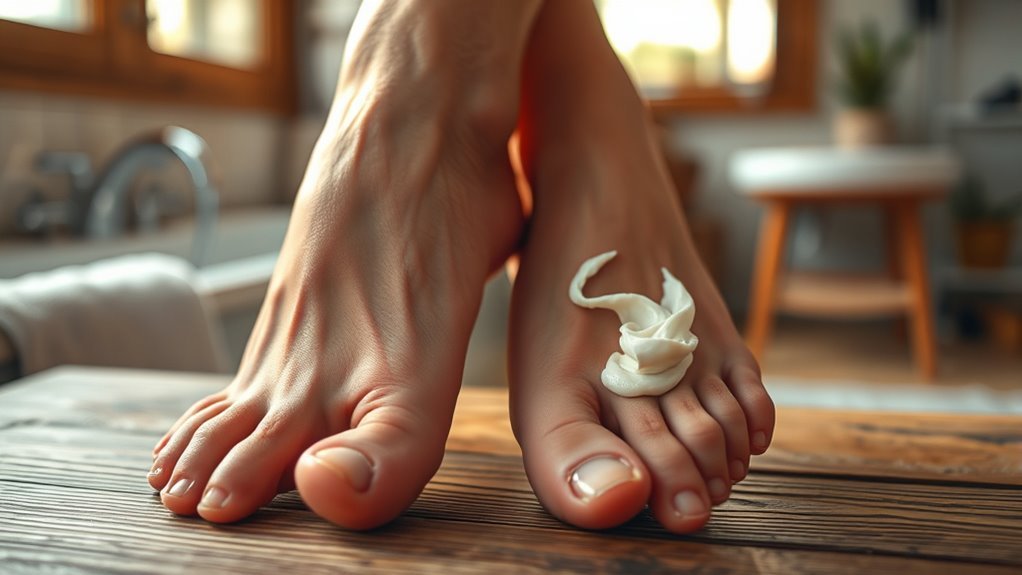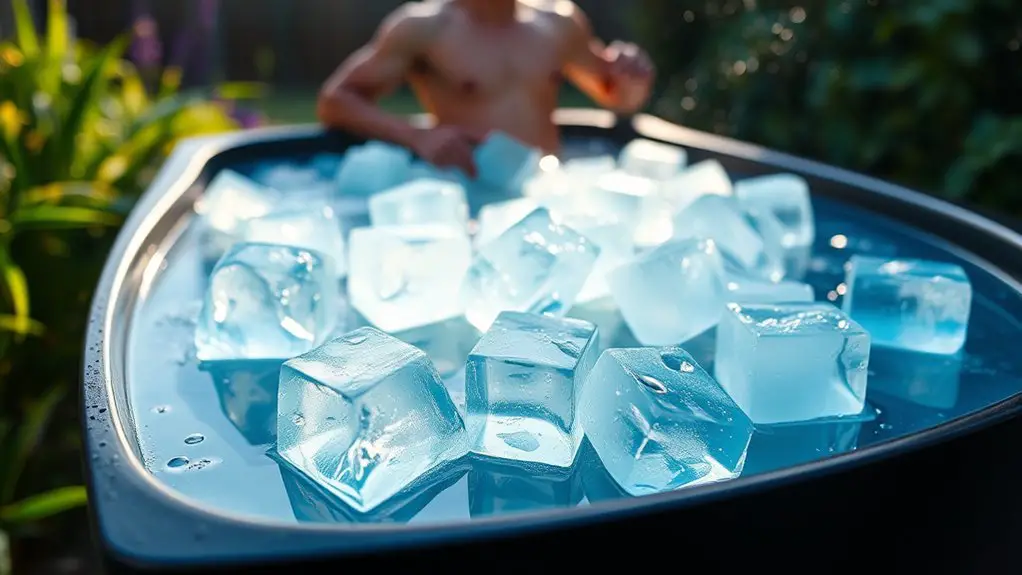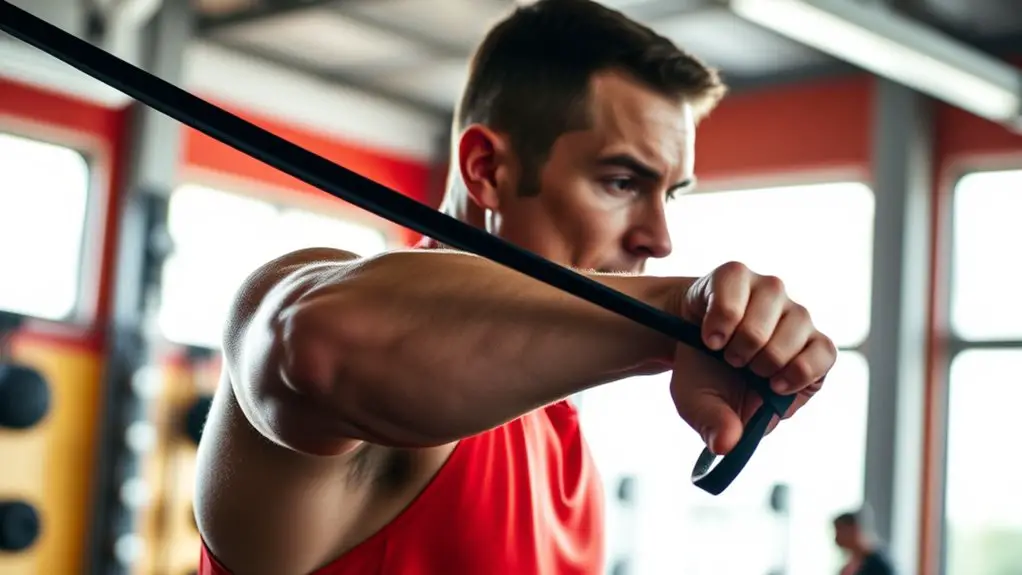Yes, you can cure athlete’s foot with the right treatments and preventive measures. Over-the-counter antifungal creams, powders, and sprays can effectively target the infection. Home remedies like tea soaks and garlic paste also promote healing. It’s essential to maintain good foot hygiene, dry your feet thoroughly, and wear breathable shoes to prevent recurrence. If symptoms persist or worsen despite treatment, seeking professional help is advisable. There’s more to learn about managing and preventing athlete’s foot effectively.
Understanding Athlete’s Foot: What It Is and How It Develops
Athlete’s foot, a common fungal infection, can be both uncomfortable and embarrassing. This pesky condition thrives in warm, damp environments, often developing when your feet are confined in tight shoes or exposed to public showers. The fungus can spread easily, especially if you’re sharing spaces like locker rooms or swimming pools. As you go about your daily life, it’s essential to understand how skin irritation can signal the presence of this infection. You might notice redness, peeling, or itchiness on your feet, which could indicate a growing problem. Taking proactive steps to keep your feet dry and clean can help you reclaim your freedom from this unwelcome intruder. Don’t let athlete’s foot hold you back from enjoying life to the fullest!
Common Symptoms of Athlete’s Foot
When you’re dealing with athlete’s foot, it’s essential to recognize the common symptoms that signal an infection. You might notice itching, burning, or stinging between your toes, often accompanied by redness and peeling skin. Blisters can also form, leading to discomfort. In some cases, your feet may develop a foul odor, making it clear that something’s off. Symptom identification is key to addressing the issue quickly. If you experience these signs, don’t hesitate to explore treatment options, like over-the-counter antifungal creams or powders. Taking action early can help you regain your freedom from the frustration of athlete’s foot, allowing you to get back to your favorite activities without the nagging discomfort of an infection.
Causes and Risk Factors Associated With Athlete’s Foot
Though often dismissed as a minor annoyance, athlete’s foot can stem from a variety of causes and risk factors that you should be aware of. Fungal infections thrive in warm, moist environments, making damp shoes or sweaty socks a breeding ground for these pesky invaders. If you spend a lot of time in communal showers or locker rooms, you’re also at a higher risk. Moisture retention is a key player, as it allows fungi to flourish between your toes. Plus, if your immune system is weakened, you may be more susceptible to these infections. Understanding these factors can empower you to take preventive measures, ensuring you enjoy life without the discomfort of athlete’s foot holding you back.
Over-the-Counter Treatments for Athlete’s Foot
If you find yourself dealing with athlete’s foot, there are several effective over-the-counter treatments to contemplate. These options can help you regain comfort and freedom in no time. Here’s a quick list to guide your choices:
- Topical creams – Creams like clotrimazole or miconazole can target the infection directly.
- Antifungal powders – Sprinkling antifungal powders can keep your feet dry and prevent further irritation.
- Sprays – Antifungal sprays are convenient and can be applied quickly.
- Soaks – Soaking your feet in a vinegar solution can help ease itching and promote healing.
Prescription Medications for Severe Cases
If over-the-counter treatments aren’t cutting it, you might need prescription medications for severe cases of athlete’s foot. Topical antifungal treatments can offer stronger relief, while oral antifungal medications may be necessary for persistent infections. Understanding the duration of treatment is also key to ensuring you fully clear the infection.
Topical Antifungal Treatments
When over-the-counter antifungal treatments aren’t enough to clear up athlete’s foot, prescription medications can provide a more potent solution. These topical applications are essential, especially for severe cases where fungal resistance may complicate recovery. Here are a few options your doctor might consider:
- Clotrimazole – Targets the fungus effectively, providing relief fast.
- Terbinafine – Known for its strong action against stubborn infections.
- Miconazole – A versatile choice that disrupts fungal growth.
- Econazole – Offers broad-spectrum coverage with minimal side effects.
Using these topical treatments can help you regain your freedom from discomfort and banish athlete’s foot for good. Remember, consulting your healthcare provider is key to finding the right solution for you.
Oral Antifungal Medications
For stubborn cases of athlete’s foot that don’t respond to topical treatments, oral antifungal medications can be a game-changer. These powerful oral medications dive deep, targeting the root of the infection and bringing you closer to that sweet relief you crave. When topical options fall short, these prescriptions are often your best bet to reclaim your freedom from discomfort. Typically, the treatment duration can range from several weeks to a few months, depending on the severity of your condition. It’s essential to follow your healthcare provider’s instructions and complete the full course to guarantee the infection doesn’t return. With the right approach, you can say goodbye to athlete’s foot and embrace a life free of irritation.
Duration of Treatment
Although the duration of treatment for severe cases of athlete’s foot can vary, you can generally expect to be on prescription antifungal medications for a minimum of two to four weeks. Your healing timeline will depend on the severity of the infection and how well you respond to the treatment. Here are some key points to keep in mind:
- Follow your doctor’s dosage instructions closely.
- Keep your feet clean and dry to enhance effectiveness.
- Monitor any changes in symptoms; report any concerns promptly.
- Be patient—complete the full course, even if you feel better sooner.
Home Remedies: Natural Approaches to Treating Athlete’s Foot
If you’re looking for natural ways to tackle athlete’s foot, several home remedies can help alleviate the discomfort and clear up the infection. Try soaking your feet in tea soaks or an Epsom salt bath to soothe irritation. A paste made from garlic or turmeric can provide potent antifungal properties. Baking soda mixed with water can help absorb moisture and relieve itching, while a vinegar rinse balances the skin’s pH. Essential oils like tea tree or lavender, combined with coconut oil, can promote healing. Don’t forget aloe vera for its soothing qualities, or an oatmeal bath for extra relief. These natural remedies allow you to reclaim your comfort and enjoy life without the itch!
Importance of Proper Foot Hygiene
Proper foot hygiene is essential, not just for preventing athlete’s foot but for overall foot health. When you prioritize foot care, you can enjoy freedom in your activities without discomfort. Here are some key hygiene practices to keep your feet happy:
- Wash Daily: Clean your feet with soap and water every day, especially between the toes.
- Dry Thoroughly: After washing, make sure to dry your feet completely to prevent moisture buildup.
- Choose Breathable Footwear: Opt for shoes made of natural materials that allow air circulation.
- Change Socks Regularly: Fresh, dry socks help keep your feet dry and reduce the risk of fungal infections.
Preventative Measures to Avoid Recurrence
Maintaining good foot hygiene is just the first step in keeping athlete’s foot at bay. You’ve got to embrace moisture control to truly kick that pesky fungus to the curb. Choose breathable socks made of natural fibers, as they help wick away sweat. When it comes to footwear choices, opt for shoes that allow for airflow. Avoid tight-fitting shoes and rubber boots, which can trap heat and moisture. Rotate your shoes to give them time to dry out between wears. Don’t forget to keep your toenails trimmed and clean, and always wear flip-flops in public showers or pools. By making these simple changes, you can enjoy your freedom without the worry of athlete’s foot creeping back into your life.
When to Seek Professional Help for Athlete’s Foot
If your athlete’s foot symptoms persist despite treatment, it might be time to consult a professional. Severe discomfort can also signal that you need expert advice to prevent further complications. Don’t hesitate to seek help when your well-being is at stake.
Persistent Symptoms
While most cases of athlete’s foot can be managed at home, there are times when persistent symptoms signal the need for professional help. If you’re dealing with ongoing issues, don’t hesitate to reach out. Consider seeking help if you experience:
- Persistent itching that doesn’t improve after treatment.
- Redness or swelling that worsens over time.
- Foul odor that makes you uncomfortable.
- Signs of fungal resistance, where over-the-counter treatments just aren’t cutting it.
Ignoring these signs can lead to more significant issues down the line, so trust your instincts. Remember, your freedom from discomfort is worth pursuing the right help!
Severe Discomfort
Persistent symptoms can often lead to severe discomfort, making it difficult to ignore the problem any longer. If you find that your athlete’s foot is causing discomfort that disrupts your daily life, it may be time to seek professional help. Here are some signs it’s essential to consult a doctor:
| Symptoms | When to Seek Help | Possible Treatment Options |
|---|---|---|
| Intense itching | If it lasts over a week | Prescription antifungals |
| Redness and swelling | If it worsens or spreads | Topical treatments |
| Painful blisters | If they become infected | Oral medication |
| Persistent odor | If home remedies fail | Specialized care |
Frequently Asked Questions
Can Athlete’s Foot Be Contagious to Others?
Yes, athlete’s foot can be contagious. Think of it like a sneaky villain in a superhero movie; it spreads easily in damp places like locker rooms or pools. To avoid battling this foe, stick to prevention methods like wearing flip-flops in shared spaces and keeping your feet dry. If you do get it, treatment options include antifungal creams or powders. Stay vigilant, and you can keep your feet free from this pesky invader!
How Long Does Athlete’s Foot Typically Last?
Athlete’s foot usually lasts a few weeks, but it can linger longer if you don’t treat it properly. Symptom duration can vary based on how quickly you start treatment. Over-the-counter antifungal creams are effective options, and they can help clear it up within a week or two. Just remember, keeping your feet dry and clean is essential for quick relief and preventing future flare-ups. Don’t let it hold you back!
Can I Still Exercise With Athlete’s Foot?
Yes, you can still exercise with athlete’s foot, but it’s smart to make some modifications. Consider low-impact activities that don’t put too much strain on your feet, like cycling or swimming. Pay attention to your footwear choices; wearing breathable shoes and moisture-wicking socks can help. Just be cautious not to spread the infection, and keep your feet clean and dry. Enjoy your workouts while taking care of your feet!
Are There Dietary Changes That Help With Athlete’s Foot?
A diet rich in immune-boosting foods can work wonders for your athlete’s foot. Think vibrant fruits, crunchy veggies, and whole grains that’ll have your body singing with health. Add in some dietary supplements like vitamin C and zinc for extra immune support, and you’ll be dancing through life, free from discomfort. Remember, when your body’s fortified, it’s got a better shot at kicking that pesky infection to the curb!
Will Athlete’s Foot Go Away on Its Own?
Yes, athlete’s foot can sometimes go away on its own, but it’s unpredictable. If you prefer a more proactive approach, consider using home remedies like tea tree oil or garlic, which are popular natural treatments. These can help speed up healing and relieve discomfort. However, if it persists, you might want to consult a healthcare professional for additional advice. Embrace your freedom to choose what feels right for your body!




